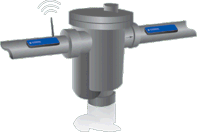March 2009
![]()
AutomatedBuildings.com
[an error occurred while processing this directive]
(Click Message to Learn More)
March 2009 |
[an error occurred while processing this directive] |
|
|
Many buildings and facilities produce steam for heating, sterilization or manufacturing processes. The steam is typically piped from a central boiler(s) to various locations on site where the steam is used.
|
|
|
|
|
|
|
|
|
|
|
|
|
|
|
|
|
|
|
|
|
[an error occurred while processing this directive] |
“Steam traps” are mechanical devices installed on the pipes to remove condensate from the steam flow; they are needed to maintain the proper operation of the steam distribution system. A typical hospital or university campus may have several hundred or even thousands of steam traps.
Unfortunately, steam traps have a tendency to leak, and even a single leaking trap can waste up to thousands of dollars of energy per year. According to the US Department of Energy, on average 15-25% of steam traps are leaking at existing installations, which means hundreds of thousands of dollars of wasted energy per year per site. It is therefore critical to detect and correct failures quickly.
[an error occurred while processing this directive] Most facilities perform a steam trap audit once a year, which usually involves sending technicians to a steam trap (many in relatively inaccessible locations), and manually inspecting it with hand-held devices e.g. Infrared Thermography detectors. Defective steam traps are fixed when identified by the audit.
The audits are time-consuming, averaging 10-15 minutes to locate, measure, and document each steam trap, and can take more than a week for an entire site. For this reason, audits are performed infrequently, usually once a year. Given the typical failure rate of steam traps, this means that many start leaking during the course of a year and are not detected for many months (till the next audit).
In between audits, leaks would occur without intervention, and would waste over a hundred thousand dollars even for a smaller site with a few hundred steam traps.
Wireless Steam Trap Monitor
 Instead
of performing manual audits just described, facility managers can now use new
technology like the Wireless Steam Trap Monitor (WSTM) from
Cypress Envirosystems to
detect steam trap failures almost immediately, and to repair or replace the
defective units. The amount of steam wasted in this case would be a small
fraction of an undetected leak.
Instead
of performing manual audits just described, facility managers can now use new
technology like the Wireless Steam Trap Monitor (WSTM) from
Cypress Envirosystems to
detect steam trap failures almost immediately, and to repair or replace the
defective units. The amount of steam wasted in this case would be a small
fraction of an undetected leak.
This technology non-invasively clamps on top of steam traps, performs monitoring and diagnostics and transmits health status wirelessly to a central receiver and server for monitoring, trending, graphing, alarming and historization. Each WSTM installs in minutes, and does not involve breaking seals, leak checks, or system downtime.
The WSTM data can be shared with existing building automation systems via BACnet/IP or LON, so no new software or operator training is needed to implement this solution.

To illustrate how compelling the benefits can be, Genentech (a leading biotechnology company) shared their experience in using WSTM’s at the annual Automation Research Corp. conference in January 2009. 56 units were installed at their headquarters campus in California which included office buildings and laboratories. Within a few months after the initial installation, 14 leaking traps were detected and energy loss was avoided. The payback period for this project was five months!
About The Author
Harry Sim is the CEO and founder of Cypress Envirosystems (www.CypressEnvirosystems.com), a subsidiary of Cypress Semiconductor. Its mission is to save energy and improve productivity in older plants and buildings, using state-of-the-art non-invasive and wireless technologies to minimize disruption and cost, and delivering payback of 12 months or less. Prior to Cypress Envirosystems, Harry was the Global Vice-President of Marketing for Honeywell’s Industrial Process Control division. During his 15 years with Honeywell, he held executive positions in General Management, Strategy, Mergers and Acquisitions, and Internet Startup founder.
[an error occurred while processing this directive]
[Click Banner To Learn More]
[Home Page] [The Automator] [About] [Subscribe ] [Contact Us]